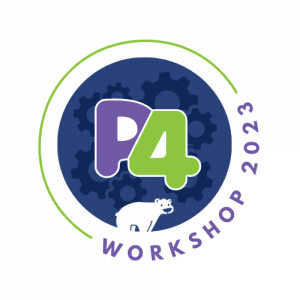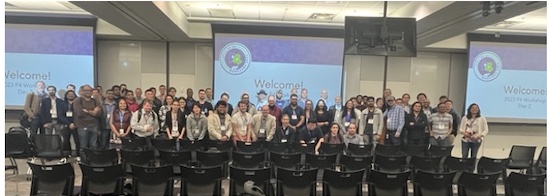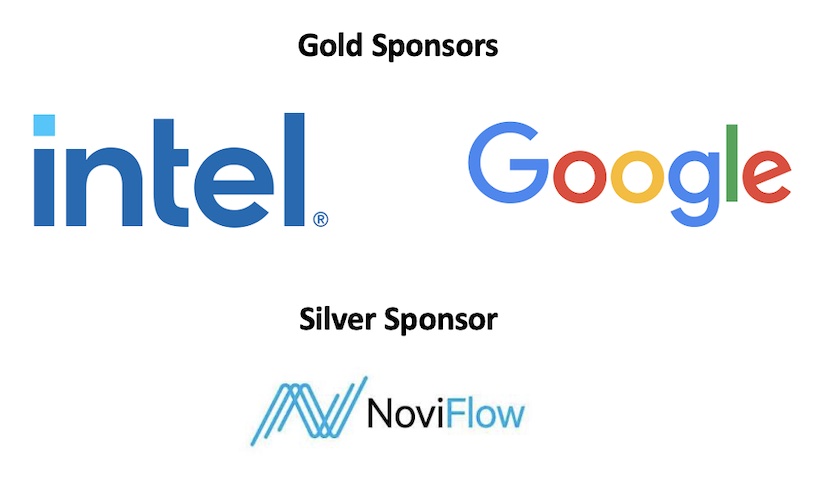
The annual 2023 P4 Workshop took place April 24-25th and was hosted in-person at Intel headquarters in Santa Clara, California. It was a great opportunity for exchange of insights and ideas and included 28 talks as well as demos and posters. The keynote sessions were recorded and the videos plus slides are now accessible on-demand. You can also view slides from the in-depth talks, lightning talks and P4 Working Groups sessions - register to access all the insights shared by P4 community members during this event.

“The Future of P4, Revisited” by P4 Workshop General Chair, Larry Peterson
In a recent newsletter posted on Systems Approach, Larry shared his observations and insights from the 2023 P4 Workshop including the impact of Intel’s Tofino 3 announcement earlier this year and the bright future for P4. “The march to programmable networks is inevitable (in my view), and I’m still optimistic about the central role P4 will play." | Read the Systems Approach Newsletter
Keynotes
A brief welcome by Larry Peterson, P4 Workshop General Chair, and Mina Tahmasbi Arashloo, P4 Workshop Program Chair, was followed by Andy Fingerhut who discussed the importance of P4, how it has been applied and its ongoing evolution. He highlighted some of the activities taking place across the P4 working groups.
The first keynote presenter was Rob Sherwood, NEX Cloud Networking Group CTO, Intel, on "The Power of Fully Specified Data Planes". He discussed how Intel is continuing to make significant investments in P4 and how the P4 language will evolve and possible new directions - testing, hardware qualification and software evolution. “P4 was created to solve automatic data plane configuration but the bigger, long-term contribution may be a fully-specified data plane language.”
The next keynote was by Ang Chen, Assistant Professor Computer Science, Rice University on "From Programmability to Fungibility". Programmability for networks is already here however even with programmability, these network devices lack context making them similar to a fixed function device. He introduced the Flex vision concept which provides runtime network (re)programming end-to-end; no downtime, zero packet loss, consistency guarantees - from programmability to resource fungibility. “To achieve this vision requires dynamic resource allocation within and between network/infra resources - programming, compilation, verification and management.”
Krishna Doddapaneni, Corporate Vice President, AMD Pensando delivered a keynote on "Developing Real World Applications Using P4-based Architecture", in which he discussed the advantages of the P4 architecture and shared his experience in developing and deploying real world P4 applications and use cases. “Fully programmable DPU with native P4 architecture provides flexibility and agility in developing and deploying SDN/SDS/Security services and puts power in the hands of software developers and the research community to innovate on new ideas.”
A fireside chat with Nick McKeown, P4 co-founder and evangelist, and Larry Peterson, ONF offered insights into the evolution of P4 beginning in 2012, why a programming language surfaced as a necessity to specify forwarding behavior in an unambiguous fashion, and perspectives on where P4 is going in the future. Lots of interesting questions and engagement with the audience! “As a community, if we can ensure the forwarding plane is programmable it moves the entire networking industry forward because it allows those who own and operate networks - those who understand networks the best, the power to control the network. The place to do this is in the NIC - Smart NICs not in the switches.”
Arvind Krishnamurthy, Short-Dooley Professor, Paul G. Allen School of Computer Science & Engineering, University of Washington presented a talk that explored, "Can Smart NICs Help Accelerate Distributed Systems?", which included related case studies, opportunities and challenges. “Application programmability of SmartNICs is now viable and an exciting capability - it can offload or accelerate end-host computations…but while there are many opportunities there are also many challenges ahead.”
The final keynote of the day was delivered by Parveen Patel, Google Cloud. His talk, "P4 HAL for Network Virtualization", highlighted key benefits of P4 as a HAL for Network Virtualization:, specifically target-independent controller code (abstraction layer for switch hardware); alignment on expected behavior (formal specification and behavioral model); few production bugs (automated tests). “P4 has a big opportunity and creates a win-win for users and NIC vendors - it needs a coordinated community effort across users and vendors.”
P4 Working Group Updates
Co-chairs from the P4 Language Design, P4 Architecture and P4 API working groups presented an update on the activities within each of their groups and invited discussion with the audience. Slides can be viewed on the website.
P4 Workshop Photos
We've shared photos taken during the event in a GoogleDrive folder - check it out here!
P4 Workshop Sponsors
A warm thank you to our sponsors that helped to make this event possible:


